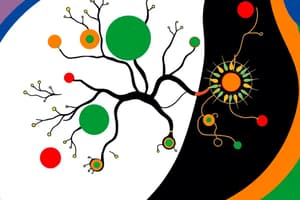Podcast
Questions and Answers
What is the primary difference between passive transport and active transport?
What is the primary difference between passive transport and active transport?
- Passive transport uses energy, while active transport does not.
- Passive transport requires carrier proteins, while active transport does not.
- Passive transport moves substances against their concentration gradient, while active transport moves substances with it.
- Passive transport occurs spontaneously, while active transport requires energy. (correct)
What is the correct order of processes involved in protein synthesis?
What is the correct order of processes involved in protein synthesis?
- Transcription, replication.
- Replication, transcription.
- Translation, transcription.
- Transcription, translation. (correct)
Which statement best describes natural selection?
Which statement best describes natural selection?
- It allows organisms with less advantageous traits to survive better.
- It leads to an increased mutation rate in organisms over time.
- It is the process in which all organisms are equally likely to reproduce.
- It favors the survival and reproduction of organisms with advantageous traits. (correct)
Which of the following is NOT a component of an ecosystem?
Which of the following is NOT a component of an ecosystem?
What is the first step in the scientific method?
What is the first step in the scientific method?
What is the primary function of carbohydrates in living organisms?
What is the primary function of carbohydrates in living organisms?
Which of the following is a characteristic shared by all living organisms?
Which of the following is a characteristic shared by all living organisms?
In which level of biological organization do cells come together to form a functional unit?
In which level of biological organization do cells come together to form a functional unit?
Which type of cell is characterized by the absence of a nucleus?
Which type of cell is characterized by the absence of a nucleus?
What process do plants use to convert light energy into food?
What process do plants use to convert light energy into food?
Which organelle is primarily involved in energy production within a cell?
Which organelle is primarily involved in energy production within a cell?
What is the highest level of biological organization?
What is the highest level of biological organization?
Which type of biomolecule primarily serves as a source of stored energy in cells?
Which type of biomolecule primarily serves as a source of stored energy in cells?
Flashcards
Mitosis
Mitosis
The process by which cells reproduce, resulting in two identical daughter cells. This involves copying the entire DNA and splitting the cell contents.
Meiosis
Meiosis
A type of cell division that produces gametes (sperm and egg cells) with half the number of chromosomes as the parent cell, ensuring genetic diversity in offspring.
Transcription
Transcription
The process of converting DNA information into a messenger RNA (mRNA) molecule, which then carries the code for protein synthesis.
Translation
Translation
Signup and view all the flashcards
Genetic Mutation
Genetic Mutation
Signup and view all the flashcards
What is Biology?
What is Biology?
Signup and view all the flashcards
What are the levels of Biological Organization?
What are the levels of Biological Organization?
Signup and view all the flashcards
What is Metabolism?
What is Metabolism?
Signup and view all the flashcards
What is Reproduction?
What is Reproduction?
Signup and view all the flashcards
What are Biological Molecules?
What are Biological Molecules?
Signup and view all the flashcards
What is a Cell?
What is a Cell?
Signup and view all the flashcards
What is Cellular Respiration?
What is Cellular Respiration?
Signup and view all the flashcards
What is Photosynthesis?
What is Photosynthesis?
Signup and view all the flashcards
Study Notes
Introduction to Biology
- Biology is the scientific study of life and living organisms.
- It encompasses a vast range of topics, from the smallest molecules within cells to the largest ecosystems on Earth.
- The study of biology is crucial for understanding the world around us and addressing many global challenges.
Levels of Biological Organization
- Biological systems are organized in a hierarchical fashion, from the smallest to the largest scale.
- Atoms combine to form molecules.
- Molecules form organelles.
- Organelles form cells.
- Cells form tissues.
- Tissues form organs.
- Organs form organ systems.
- Organ systems make up organisms.
- Organisms interact to form populations.
- Populations interact to form communities.
- Communities interact with their physical environment to form ecosystems.
- Ecosystems collectively form the biosphere.
Characteristics of Living Organisms
- All living organisms share several key characteristics:
- Cellular organization: They are composed of one or more cells.
- Metabolism: They use energy to maintain life.
- Reproduction: They can create new organisms.
- Growth and development: They increase in size and complexity over time.
- Adaptation: They can adjust to changes in their environment.
- Response to stimuli: They react to external factors.
- Homeostasis: They regulate internal conditions.
Biological Molecules
- Four major classes of biomolecules are essential for life:
- Carbohydrates: Provide energy and structural support.
- Lipids: Store energy, form cell membranes, and act as hormones.
- Proteins: Perform diverse functions such as catalyzing reactions and transporting substances.
- Nucleic acids: Store and transmit genetic information.
Cell Structure and Function
- Cells are the fundamental units of life.
- Prokaryotic cells lack a nucleus and membrane-bound organelles.
- Eukaryotic cells have a nucleus and membrane-bound organelles.
- The cell membrane regulates what enters and exits the cell.
- Organelles have specific functions within the cell, such as energy production (mitochondria) and protein synthesis (ribosomes).
Cell Processes
- Cells use energy to carry out essential processes, including:
- Cellular respiration: The process of breaking down glucose to release energy.
- Photosynthesis: The process by which plants and some other organisms use light energy to synthesize food.
- Transport processes: Movement of substances across cell membranes. Passive transport (diffusion, osmosis) moves things without energy; active transport requires energy.
- Cell division (mitosis and meiosis): The process by which cells reproduce.
Genetics
- Genes are segments of DNA that contain instructions for building proteins.
- DNA carries the genetic code.
- The process of protein synthesis involves transcription (creating mRNA from DNA) and translation (using mRNA to build proteins).
- Genetic mutations can lead to changes in the organism.
Evolution
- Evolution explains the diversity of life on Earth.
- Natural selection is a key mechanism of evolution, where organisms with advantageous traits are more likely to survive and reproduce.
- Adaptations enhance an organism's survival and reproduction in a given environment.
Ecology and Ecosystem Dynamics
- Ecology studies the interactions between organisms and their environment.
- Ecosystems are composed of biotic (living) and abiotic (non-living) components.
- Organisms interact within ecosystems through different relationships, such as predation and competition.
- Energy flows through ecosystems; matter cycles through them.
Classification of Living Organisms
- Scientists classify organisms into hierarchical groups based on shared characteristics. This allows for organisation and understanding of relationships.
- The categories range from kingdom (largest) to species (smallest).
Scientific Method
- The scientific method provides a systematic approach to understanding the natural world.
- This process involves making observations, formulating hypotheses, designing experiments, analyzing data, and drawing conclusions.
Studying That Suits You
Use AI to generate personalized quizzes and flashcards to suit your learning preferences.




